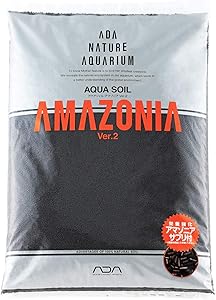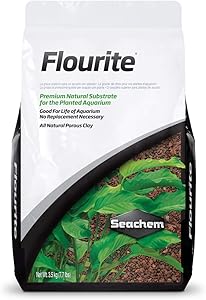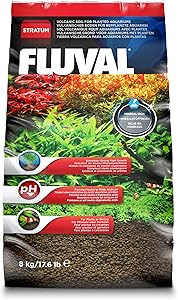For many aquarists, the aquarium gravel is nothing more than a decorative feature.
But for a planted aquarium, the gravel bed or “substrate” is a key component in the success of the tank.
Just like land plants, aquatic plants take in nutrients from the soil through their roots.
Using the wrong substrate can inhibit plant growth while a good aquatic plant substrate will enhance growth and make aquatic gardening easier.

In this article
- The difference between a fish tank and a planted aquarium
- How aquatic plants get nutrients
- Best rated Aquatic Plant Substrates
- How much substrate will I need?
- Why not use garden soil in the aquarium?
- Will I need to fertilize my plants?
- Can I use carbon dioxide fertilization?
- Can I use regular aquarium gravel?
- Specialty substrates for planted aquariums
- Can I add a substrate to an established aquarium?
- Should I wash specialty substrates before using them?
- Recommendations
The difference between a fish tank and a planted aquarium
A fish tank is a setup with the goal of keeping a beautiful aquarium of tropical fish. It’s all about the fish. In a tank of digging cichlids or plant-eating fish, there is no place for live plants.
A planted aquarium is different. The goal is to provide an environment for the aquatic plants first and foremost.
That means everything from the lighting system to the gravel is selected with the plants in mind. Even the fish must be plant-safe.
How aquatic plants get nutrients
In nature, many aquatic plants live partially submerged until the rainy season comes. Then they’re completely submerged.
While nutrients can be absorbed through the leaves, the roots are the main way aquatic plants get their nutrition.
That’s why the substrate is so important for the long-term success of a planted aquarium.
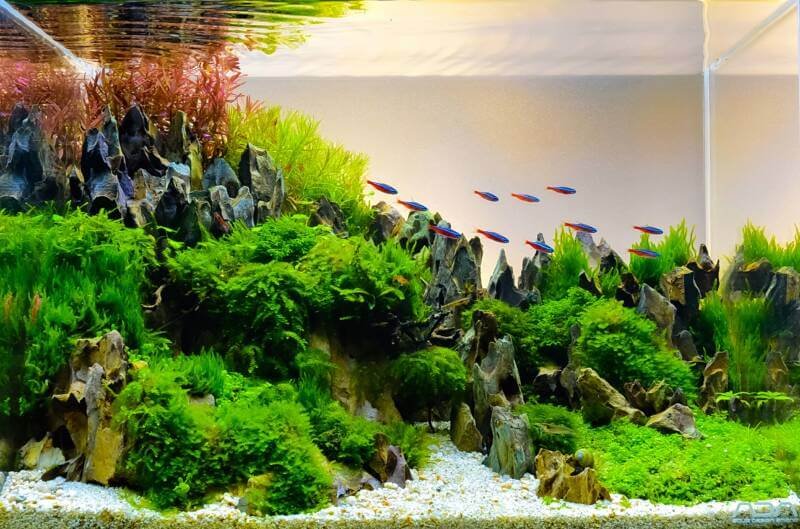
Best rated Aquatic Plant Substrates
There are many aquatic plant substrates to choose from. They come in a variety of colors and materials.
They’re not all the same! I took a look at the top brands and reviewed the features and benefits of each.
These are some of the best substrates for planted aquariums.
Amano Soil Amazonia is a man-made substrate that uses natural peat-like materials.
Amazonia substrate is very smooth which is perfect for keeping soft-bellied fish like cory catfish and loaches.
This substrate is naturally rich in organic acids and trace elements.
The peat in ADA Aqua Design Amano Soil Amazonia is slightly acidic and will gradually lower pH and carbonate hardness. This is especially beneficial as it makes nutrients in the substrate more absorbable by plant roots.
Amazonia will slowly release a small amount of ammonia into the water. This is quickly absorbed by the plants as a nitrogen source.
You have to be careful not to disturb the substrate too much when adding plants. It can cause cloudy water because the substrate is a little bit like soil instead of hard gravel.
ADA Aqua Soil Amazonia Powder is a much finer substrate. It looks more to scale in smaller nano aquariums. It can also be layered over the full-size ADA substrate without looking mismatched.
ADA Light substrate is made from the same mineral and organic matter but has lighter color. ADA Light releases less ammonia than standard ADA soils.
Pros
- Natural appearance
- Won’t scratch bottom-dwelling fish
- Light-weight
- Helps acidify the aquarium.
Cons
- Disturbing the substrate may cloud the water.
Flourite is one of the first planted aquarium substrates made in the US.
Flourite is a dense, hard clay material with many trace elements baked in.
It’s porous, with a high surface area. This makes Fluorite great for supporting a biological filter and stimulating plant growth.
This substrate is not coated with epoxy or paint. The red color is completely natural. Flourite contains minerals like iron, that are slowly released to the roots.
Flourite’s hard structure won’t soften or break down over time.
Pros
- All-natural
- Won’t affect the pH
- Fine grain size locks plants in place
- Attractive black color
Cons
- Requires a lot of rinsing
- May cause temporary clouding of the aquarium
Carib Sea’s Eco-Complete planted aquarium substrate is made from natural basaltic ore.
It contains magnesium, potassium, sulfur, and calcium along with essential trace elements like iron, manganese, and zinc.
Carib Sea Eco-Complete Planted Aquarium Substrate is a shipped damp because it contains live bacteria. The bacteria kick-start biological filtration when first starting a new tank.
This substrate also contains Floraspore microbes, which make nutrients available for plant uptake.
You should not rinse the gravel before use because it will wash away the beneficial bacteria.
Eco Complete is hard, mineral-based gravel. This means you can siphon the gravel or move plants around without causing cloudy water.
Pros
- Dust-free
- Helps start new aquariums
- Contains over 20 essential nutrients
- Attractive brick-red color
- Won’t cloud the water
Cons
- Water may be cloudy when first filling the aquarium with water
- Gravel size is a bit large for planted aquariums
Fluval Plant and Shrimp Stratum is a 100% natural mineral containing no synthetic binders or coatings. Stratum is mined from Mount Aso Volcano in Japan.
This soil, known for its rich mineral content, contains essential minerals needed by all aquarium plants.
Stratum has a smooth surface making it ideal for delicate shrimp. Soft-bellied fish like catfish will enjoy the soft substrate too.
Fluval Plant and Shrimp Stratum provides a decorative cocoa-colored substrate that fits into any aquascape.
This substrate is lightweight and easily sucked up by gravel siphons. Use care when cleaning the gravel bed.
Pros
- Porous structure encourages bacteria attachment
- Attractive color
- The soft, light-weight substrate allows roots to branch out
- Acidifies the root zone, making nutrients available for absorption
Cons
- Difficult to clean with a siphon
- Very dusty and clouds water when disturbed
- Granules disintegrate after a few years
Estes is one of the leading aquarium gravel manufacturers in the US.
This substrate starts as natural pebbles that are cleaned and polished to create a smooth surface and beautiful colors. The pebbles are coated with epoxy to ensure the substrate stays dust-free during shipping.
The clear coating also makes the gravel inert, meaning it won’t change pH or water hardness.
This gravel does not release minerals to the plant roots. Fertilizer tablets are recommended.
The Super Naturals line of gravel is all-natural with no epoxy coating.
It won’t change water hardness, alkalinity, or pH.
It’s not a specialty plant soil but can be used to create a planted aquarium. The small gravel will secure the plant roots and provide an attractive aquascape.
How much substrate will I need?
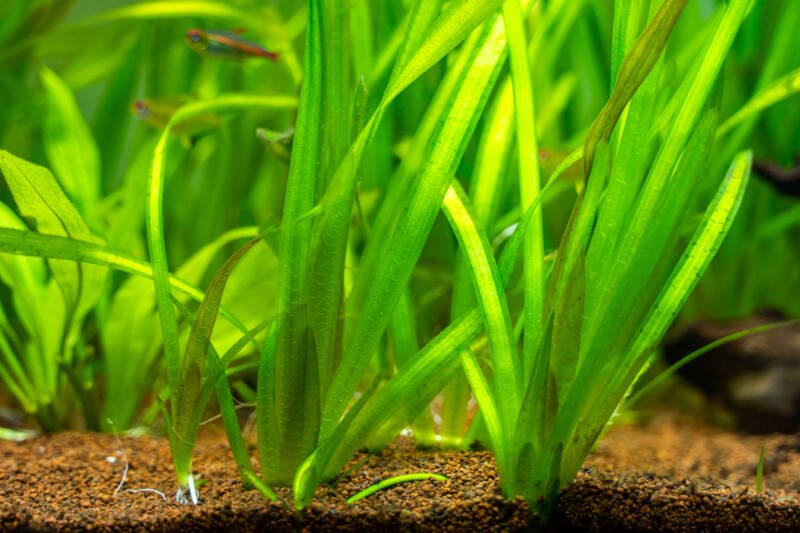
You want the substrate to be about 2-2.5 inches deep.
This allows you to push fertilizer tablets deep into the root zone where the nutrients can be absorbed by the plants and not dissolve into the water.
The gravel bed also provides room for the roots to spread out and anchor the plants.
It’s not possible to give a general “pounds per gallon” formula because the density varies by substrate type. Most substrate manufactures provide a usage recommendation.
You’ll also find online calculators like this one.
Why not use garden soil in the aquarium?
In nature, aquatic plants spread their roots throughout the soil in a bog, lake, or stream bed. The roots anchor the plant and extract nutrients from the soil.
Natural aquatic soils are a combination of minerals, clay, leaf fragments, and other organic matter that have accumulated, layer upon layer, over time.
Advanced aquarists sometimes use a thin layer of real soil under the gravel but it requires expertise most beginners don’t have.
Using the wrong type of soil will decay, discolor the water, and release harmful hydrogen sulfide into the water.
Will I need to fertilize my plants?
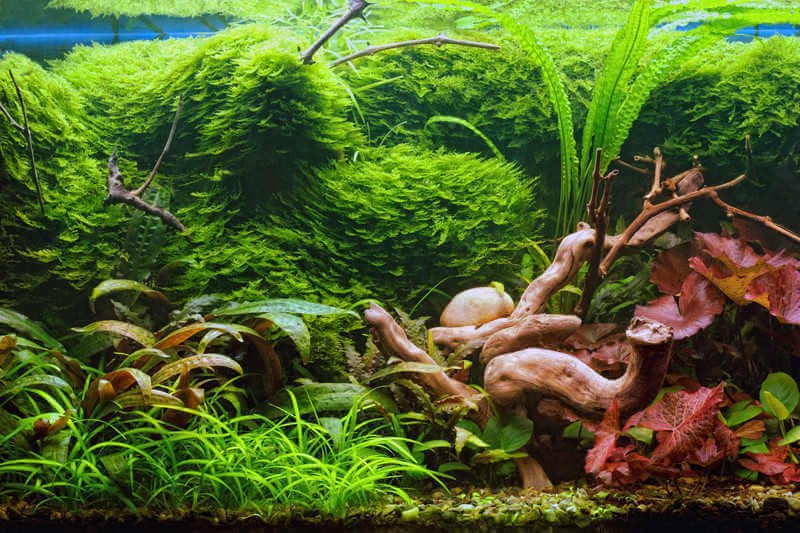
Yes. Specialty substrates contain minerals and trace elements but they’re locked up inside the granules or mineral structure.
It takes time for the substrate to become a microscopic biotope where minerals are slowly released by chemical and biological processes.
No substrate contains all the nutrients your plants need.
You’ll need to use a tablet or liquid fertilizer to ensure the plants are getting all the essential nutrients required for growth and full coloration.
Can I use carbon dioxide fertilization?
Yes. CO2 fertilization compliments tablet fertilizers. Carbon dioxide is often lacking in planted aquariums.
CO2 fertilization replenishes carbon and stimulates plant growth. There are many liquid and tablet aquatic fertilizers for aquarium plants, but none add CO2.
The most effective way to correct a carbon deficiency is by adding carbon dioxide gas to the aquarium.
Many plant enthusiasts say it makes keeping aquatic plants much easier.
Can I use regular aquarium gravel?

It’s difficult to define what “regular aquarium gravel” is since there are so many types available.
Large pebble gravel is not recommended. The large, open spaces in between the pebbles don’t create a soil-like environment around the roots.
Fine sand packs too tightly and makes it difficult for the roots to spread out and anchor the plants.
Neither substrate contains any nutrients for the plants.
Some manufacturers make small-sized gravel that looks natural and can work well in a planted aquarium.
Specialty substrates for planted aquariums
The best solution is to use a specialty aquatic substrate instead of standard aquarium gravel.
They’re screened to the right size, look natural, and won’t upset the water chemistry.
Some substrates contain trace elements like iron. Others are made from compressed clay and peat.
No man-made substrate contains all the nutrients plants need to thrive.
Can I add a substrate to an established aquarium?
If your present aquarium isn’t set up for live plants, it’s best to start fresh and do it correctly.
Trying to blend specialty substrate into traditional gravel will be messy and won’t look natural.
Should I wash specialty substrates before using them?
It depends on the substrate.
Some aquatic plant substrates are made of hard clays. These can be given a quick rinse to remove dust.
For some of them, it’s better not to rinse before use because it will wash away the beneficial bacteria that they contain.
Washing of specialty substrates that are more soil-like just will create a muddy mess.
Read the instruction on the package. It will tell you how to use the product.
Recommendations
I’ll start with an unusual recommendation first. If you like the look of traditional aquarium gravel but want to grow live plants, Spectrastone and Super Naturals will work, provided you use tablet fertilizers near the plants.
Better yet, first, add a thin layer of a specialty substrate like Fluval Stratum. Then cover with regular gravel.
If you want to go 100% specialty substrate, Seachem Flourite makes it easy. It’s clean and looks attractive.
For the aquarist willing to work with the natural organic substrates, ADA Aqua Soils or Fluval Stratum is the way to go.
If you have any questions or comments, please post them below.
